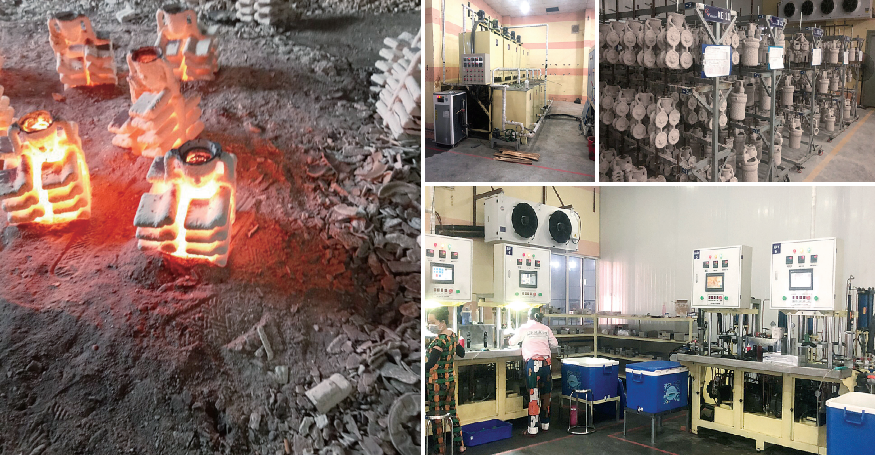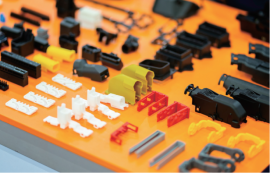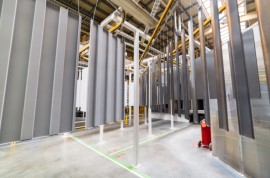Casting has become a growth industry in Vietnam, and new factories are being built one after another. The level of equipment and quality control is improving year by year, and many companies have realized overseas exports. On the other hand, there are also issues such as dependence on imports of raw materials and underdeveloped domestic infrastructure. This report details Vietnam's developing foundry industry.

Casting is one of the most crucial industries in Vietnam, with numerous foundries nationwide varying from long-standing decorative copper foundries to modern foundries that produce goods for daily life and industries.
Up to now, Vietnam's casting industry has made certain strides by investing in modern technology to produce high-quality and high-precision casting products. Some local firms have been able to produce good quality castings for heavy industry, and the foundry industry's dependence on imports has been greatly reduced.
However, Vietnam's foundry industry still lags behind other countries in terms of technology and production scale. Currently, foundry enterprises mainly produce to meet the demands of a small market, and not many have invested in modern equipment and technology. This situation has led to the underdevelopment of supporting industries in general.
In Vietnam, foundries are mainly concentrated in 9 provinces: Hai Phong, Hanoi, Vinh Phuc, Dong Nai, Thai Nguyen, Nam Dinh, Ho Chi Minh City, Hung Yen, and Hai Duong. These 9 provinces alone account for about 90% of the nation's total foundry production.
Main casting methods
In Vietnam, the main casting methods are sand casting, resin sand casting, lost-wax casting, lost-form casting, and die-casting. Below, we will introduce each of these casting types in detail.
Sand casting, Resin sand casting
Sand casting is the most popular casting method in Vietnam, followed by furan sand casting. Sand used to make molds is usually mined from Van Hai - Quang Ninh (quartz sand), Nui Thanh - Quang Nam, Ba Don - Quang Binh, and Ha Tinh. Once mined and processed, the majority of quartz sand will be used in the glass and construction glass industries, while the remainder will be used in other industries, including foundry.
The clay used to make molds usually comes from mines in Truc Thon (Hai Duong), Co Dinh (Thanh Hoa), Di Linh (Lam Dong),... Other materials such as lead chalk, sodium silicate, or coated paint are often not standardized; besides, there are no businesses specializing in production or supply. Therefore, domestic foundries often have difficulty purchasing these materials and have to import them from China, Taiwan, or Thailand. Regarding furan resin, Vietnam still depends heavily on imports. The main import market is Taiwan.
Thus, although the demand for raw molding materials is increasing, the domestic supply is not enough. Foundry businesses still rely heavily on imported raw materials.
Regarding casting materials, Vietnamese enterprises can cast most types of materials such as FC (150 ~ 300), FCD (400 ~ 600), SC, SUS, Hi-Mn, and Cr cast iron. In particular, chromium alloy cast iron is no longer produced in Japan but is quite popular in Vietnam.
Medium-frequency electric furnaces and high-frequency electric furnaces are used for melting. Japanese FDI enterprises often use electric furnaces made in Japan (Kitashiba Electric, Fuji Electric, etc.), while most Vietnamese enterprises use electric furnaces made in China. Recently, the number of Vietnamese companies using electric furnaces originating from Taiwan has been increasing. Investing in using Japanese electric furnaces is also the dream of many Vietnamese businesses, but it is still difficult to realize due to price problems. As for electricity, the power outages and momentary blackouts that were common in the past are almost nonexistent, and electric furnaces operate stably.
Numerous local firms (mostly small, medium, and micro firms) located in areas known as "foundry villages" have a monthly production of about 100 tons, and manual mold-making and casting are still the most common mold-making methods. On the other hand, medium-sized or large firms are increasingly investing in modern equipment and machinery imported from abroad. For raw sand casting, F1 molding machines dominate, but more and more companies have recently introduced high-pressure molding machines (DISA) and static-pressure molding machines (FCMX). The main method for self-hardening is the furan molding method, but recently alkaline phenol molding has been increasing, especially at Japanese-affiliated foundries. In particular, plants that cast steel, aluminum, and copper alloys are using the alkali phenol molding method.
Sand casting, Resin sand casting at Duc Nam Ninh Company Limited in Thai Nguyen
Lost-wax casting, Lost-form casting
Japanese, Taiwanese, and local companies are the main players in the lost wax and lost foam industry in Vietnam.
Lost-form casting is mostly used for FC and FCD in Japan, but it is also widely used for cast steel in Vietnam.
However, in many businesses, the quality of the foam is still poor, and the mold coating made by the company itself is of poor quality. On the other hand, some companies are now using PPS plastic as foam, with durable, highly breathable mold coatings, and are getting closer to Japanese quality standards.
Lost-wax casting is very popular in Ho Chi Minh and is mainly done by Taiwanese businesses, but recently it has also begun to be considered for application by many businesses in the North. There are also some businesses that are considering using 3D printers instead of wax to mold small quantities of products.
A Vietnamese lost-wax casting enterprise said, "Local companies mainly use equipment made in Taiwan and China, but there are also companies that have introduced old Japanese machinery. Since more and more local companies are focusing on production equipment and field management, they are also able to produce lost-wax products of good quality. However, it is difficult to compete with Chinese products in terms of price since materials are almost entirely dependent on imports."
Lost-wax casting at VN-Cast Mechanical And Casting Company Limited
Die-casting
In Vietnam, the development of the household appliance manufacturing industry and the motorbike industry has led to a significant increase in die-casting enterprises, from micro and small-scale foundries to large-scale enterprises, focusing mainly on FDI enterprises from Taiwan or Japan. In recent years, the number of Vietnamese companies participating in the field of die-casting has been increasing.
A Vietnamese die-casting enterprise shared, "The main materials used for die casting in Vietnam are aluminum (ADC6, ADC12, etc.), zinc (ZDC2, ZDC3, etc.), and magnesium. The products are mostly used in motorbikes, home appliances, and electronics industries. Some businesses can produce car components, but they are mainly FDI enterprises from Japan and Taiwan. Production machinery is new from Taiwan or new/used Japanese machines. The quality of die-casting products of Vietnamese enterprises is gradually improving, many companies have therefore become level 1 and level 2 suppliers for foreign manufacturers. In terms of price, Vietnam's die-casting products are more expensive than China's. This is said to be because Vietnam still depends heavily on imported raw materials, along with inadequate domestic infrastructure (logistics, environmental treatment, etc.), as well as difficulties in administrative procedures. For example, aluminum raw materials imported from China are not of high quality, but the price is low, so businesses frequently use materials from China for products that do not require high quality."
Regarding die-casting molds, businesses can make their own molds, or order them from companies specializing in mold production. Molds produced by Vietnamese companies are also highly appreciated for their quality and are used by foreign businesses. In addition, in order to improve the design and mold manufacturing capacity of domestic enterprises, the Ministry of Industry and Trade of Vietnam is cooperating with Samsung to implement a human resource development project for the mold industry from 2020. Training is reported to focus on plastic injection molds and punching molds, but since companies often produce many different types of molds, we can expect that this project will contribute to improving the quality of die-casting production for businesses.
Die-casting products at Thanh Cong Trading and Product Joint Stock Company
Challenges for the Foundry Industry
Regarding raw materials: Apart from sand, most other raw materials used in Vietnam's foundry industry remain heavily dependent on imports. To ensure quality, Japanese foundry companies import almost 100% of their raw materials, even pig iron and scrap, from Japan and Thailand. Vietnamese companies often import raw materials from Taiwan and China. As a result, labor costs in Vietnam are currently lower than in China, but the price of castings is still higher than in China. During the survey of casting enterprises in Vietnam, we also received many comments from domestic casting enterprises that in terms of price, it is very difficult to compete with China. Therefore, when trying to procure castings in Vietnam, it may be necessary to think in terms of "China plus one" rather than just buying cheap castings.
Regarding technical level: Technical capacity: It is undeniable that the level of foundry technology in Vietnamese companies has improved in recent years due to aggressive investment in modern machinery and technology. Many large foundry companies (mainly state-owned) are trusted by and receive orders from foreign companies. In addition, many companies produce products compliant with ISO, JIS (Japan), DIN (Europe), and other standards and export them to international markets such as Japan, Korea, Canada, the US, and the EU. On the other hand, when comparing Japanese and Vietnamese companies, the quality of Japanese companies is superior. This is due to many factors, including machinery, raw materials, and human resources. When ordering castings in Vietnam, buyers are advised to clearly determine whether quality or price is more important. If quality is important, they should choose a Japanese company (capable of small quantities and high quality). If cheaper prices are desired, then Vietnamese companies (for high volume and medium to low quality) can be selected. In addition, a small number of Vietnamese firms can produce castings that are similar in quality to those of FDI firms due to their superior equipment and workforce.
Issues related to environmental pollution and labor safety: The casting process emits a large amount of dust as well as toxic emissions and wastewater, affecting the environment and workers. However, in some foundry enterprises in Vietnam, this issue has not been given due attention, especially micro foundries in long-standing craft villages. At these foundries, we often see workers wearing shorts and going shirtless to work due to overheating. Even in craft villages, despite being well aware of the harmful effects on the environment and health, the reluctance to change is still greater. Most businesses like this use old technology and machinery, so the waste they produce is very toxic. However, they do not have enough finances to invest in more modern equipment, leading to such pollution continuing to persist.
Future prospects
In the current economic downturn, most industries are facing many difficulties. The foundry industry is also suffering from declining orders and fluctuating raw material prices. However, while many companies are facing difficulties and are forced to scale back production, others are maintaining production activities. These are businesses with a diverse product range and customer base, thanks to which they can maintain a steady stream of orders. In addition, there are also a number of businesses that constantly develop new products and seek more opportunities from new markets.
Thus, the current difficult times are an opportunity for companies to explore new potential markets, innovate, and improve. We believe that no matter what the time, quality remains the top priority in the manufacturing industry. Those companies that can learn, seize opportunities, and maintain their commitment to quality will continue to grow and succeed.























